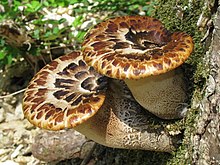Fungus
The fungus kingdom encompasses an enormous diversity of taxa with varied ecologies, life cycle strategies, and morphologies ranging from unicellular aquatic chytrids to large mushrooms.[9] Ever since the pioneering 18th and 19th century taxonomical works of Carl Linnaeus, Christiaan Hendrik Persoon, and Elias Magnus Fries, fungi have been classified according to their morphology (e.g., characteristics such as spore color or microscopic features) or physiology.[10] This in turn is derived from the Greek word sphongos (σφόγγος 'sponge'), which refers to the macroscopic structures and morphology of mushrooms and molds;[11] the root is also used in other languages, such as the German Schwamm ('sponge') and Schimmel ('mold').[40][42] Fungi have a worldwide distribution, and grow in a wide range of habitats, including extreme environments such as deserts or areas with high salt concentrations[43] or ionizing radiation,[44] as well as in deep sea sediments.[46] Most grow in terrestrial environments, though several species live partly or solely in aquatic habitats, such as the chytrid fungi Batrachochytrium dendrobatidis and B. salamandrivorans, parasites that have been responsible for a worldwide decline in amphibian populations.[53] Mycology is the branch of biology concerned with the systematic study of fungi, including their genetic and biochemical properties, their taxonomy, and their use to humans as a source of medicine, food, and psychotropic substances consumed for religious purposes, as well as their dangers, such as poisoning or infection.[54] The use of fungi by humans dates back to prehistory; Ötzi the Iceman, a well-preserved mummy of a 5,300-year-old Neolithic man found frozen in the Austrian Alps, carried two species of polypore mushrooms that may have been used as tinder (Fomes fomentarius), or for medicinal purposes (Piptoporus betulinus).[58] Extending the use of the binomial system of nomenclature introduced by Carl Linnaeus in his Species plantarum (1753), the Dutch Christiaan Hendrik Persoon (1761–1836) established the first classification of mushrooms with such skill as to be considered a founder of modern mycology.[68] The apothecium—a specialized structure important in sexual reproduction in the ascomycetes—is a cup-shaped fruit body that is often macroscopic and holds the hymenium, a layer of tissue containing the spore-bearing cells.[74] Adaptations such as these are complemented by hydrolytic enzymes secreted into the environment to digest large organic molecules—such as polysaccharides, proteins, and lipids—into smaller molecules that may then be absorbed as nutrients.[80] Growth of fungi as multicellular structures consisting of somatic and reproductive cells—a feature independently evolved in animals and plants[81]—has several functions, including the development of fruit bodies for dissemination of sexual spores (see above) and biofilms for substrate colonization and intercellular communication.Fungi have evolved a high degree of metabolic versatility that allows them to use a diverse range of organic substrates for growth, including simple compounds such as nitrate, ammonia, acetate, or ethanol.[114] Besides regular sexual reproduction with meiosis, certain fungi, such as those in the genera Penicillium and Aspergillus, may exchange genetic material via parasexual processes, initiated by anastomosis between hyphae and plasmogamy of fungal cells.[120] The earliest fossils possessing features typical of fungi date to the Paleoproterozoic era, some 2,400 million years ago (Ma); these multicellular benthic organisms had filamentous structures capable of anastomosis.[124] The evolutionary adaptation from an aquatic to a terrestrial lifestyle necessitated a diversification of ecological strategies for obtaining nutrients, including parasitism, saprobism, and the development of mutualistic relationships such as mycorrhiza and lichenization.[131] Fossilized hyphae and spores recovered from the Ordovician of Wisconsin (460 Ma) resemble modern-day Glomerales, and existed at a time when the land flora likely consisted of only non-vascular bryophyte-like plants.[146] Sixty-five million years ago, immediately after the Cretaceous–Paleogene extinction event that famously killed off most dinosaurs, there was a dramatic increase in evidence of fungi; apparently the death of most plant and animal species led to a huge fungal bloom like "a massive compost heap".[53][151] Until relatively recent (2012) changes to the International Code of Nomenclature for algae, fungi and plants, fungal species could also have multiple scientific names depending on their life cycle and mode (sexual or asexual) of reproduction.[152] Web sites such as Index Fungorum and MycoBank are officially recognized nomenclatural repositories and list current names of fungal species (with cross-references to older synonyms).[53] It recognizes seven phyla, two of which—the Ascomycota and the Basidiomycota—are contained within a branch representing subkingdom Dikarya, the most species rich and familiar group, including all the mushrooms, most food-spoilage molds, most plant pathogenic fungi, and the beer, wine, and bread yeasts.The accompanying cladogram depicts the major fungal taxa and their relationship to opisthokont and unikont organisms, based on the work of Philippe Silar,[154] "The Mycota: A Comprehensive Treatise on Fungi as Experimental Systems for Basic and Applied Research"[155] and Tedersoo et al.Rozellomycetes Mitosporidium Paramicrosporidium Nucleophaga Metchnikovellea Microsporea Aphelidiomycetes Neocallimastigomycetes Hyaloraphidiomycetes Monoblepharidomycetes Sanchytriomycetes Mesochytriomycetes Chytridiomycetes Blastocladiomycetes Physodermatomycetes Basidiobolomycetes Olpidiomycetes Neozygitomycetes Entomophthoromycetes Zoopagomycetes Dimargaritomycetes Kickxellomycetes Mortierellomycetes Calcarisporiellomycetes Umbelopsidomycetes Mucoromycetes Paraglomeromycetes Archaeosporomycetes Glomeromycetes Entorrhizomycetes Basidiomycota Ascomycota Tritirachiomycetes Mixiomycetes Agaricostilbomycetes Cystobasidiomycetes Classiculaceae Microbotryomycetes Cryptomycocolacomycetes Atractiellomycetes Pucciniomycetes Monilielliomycetes Malasseziomycetes Ustilaginomycetes Exobasidiomycetes ?Geminibasidiomycetes ?Wallemiomycetes Bartheletiomycetes Tremellomycetes Dacrymycetes Agaricomycetes Neolectomycetes Taphrinomycetes Archaeorhizomycetes Pneumocystidomycetes Schizosaccharomycetes Saccharomycetes ?Thelocarpales ?Vezdaeales ?Lahmiales ?Triblidiales Orbiliomycetes Pezizomycetes Xylonomycetes Geoglossomycetes Leotiomycetes Laboulbeniomycetes Sordariomycetes Coniocybomycetes Lichinomycetes Eurotiomycetes Lecanoromycetes Collemopsidiomycetes Arthoniomycetes Dothideomycetes The major phyla (sometimes called divisions) of fungi have been classified mainly on the basis of characteristics of their sexual reproductive structures.[157] Phylogenetic analysis has demonstrated that the Microsporidia, unicellular parasites of animals and protists, are fairly recent and highly derived endobiotic fungi (living within the tissue of another species).Members of this small phylum are anaerobic organisms, living in the digestive system of larger herbivorous mammals and in other terrestrial and aquatic environments enriched in cellulose (e.g., domestic waste landfill sites).[53] Some well-known examples of fungi formerly in the Zygomycota include black bread mold (Rhizopus stolonifer), and Pilobolus species, capable of ejecting spores several meters through the air.This phylum includes morels, a few mushrooms and truffles, unicellular yeasts (e.g., of the genera Saccharomyces, Kluyveromyces, Pichia, and Candida), and many filamentous fungi living as saprotrophs, parasites, and mutualistic symbionts (e.g. lichens).[191] Lichens occur in every ecosystem on all continents, play a key role in soil formation and the initiation of biological succession,[192] and are prominent in some extreme environments, including polar, alpine, and semiarid desert regions.[237] Fungi-based industries are sometimes considered to be a major part of a growing bioeconomy, with applications under research and development including use for textiles, meat substitution and general fungal biotechnology.[244] Other antibiotics produced by fungi include: ciclosporin, commonly used as an immunosuppressant during transplant surgery; and fusidic acid, used to help control infection from methicillin-resistant Staphylococcus aureus bacteria.[246] Other drugs produced by fungi include griseofulvin isolated from Penicillium griseofulvum, used to treat fungal infections,[247] and statins (HMG-CoA reductase inhibitors), used to inhibit cholesterol synthesis.
- Hyphal wall
- Septum
- Mitochondrion
- Vacuole
- Ergosterol crystal
- Ribosome
- Nucleus
- Endoplasmic reticulum
- Lipid body
- Plasma membrane
- Spitzenkörper
- Golgi apparatus

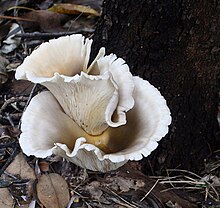
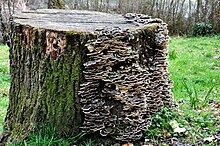

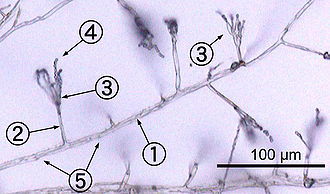
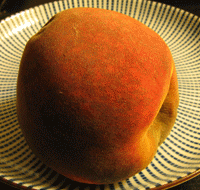
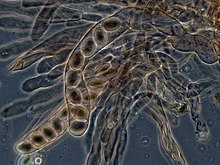
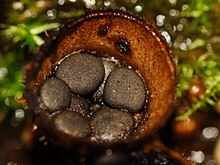

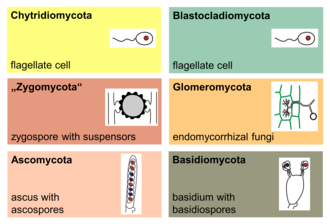



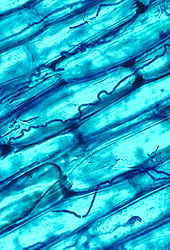
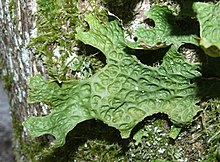



![(6aR,9R)-N-((2R,5S,10aS,10bS)-5-benzyl-10b-hydroxy-2-methyl-3,6-dioxooctahydro-2H-oxazolo[3,2-a] pyrrolo[2,1-c]pyrazin-2-yl)-7-methyl-4,6,6a,7,8,9-hexahydroindolo[4,3-fg] quinoline-9-carboxamide](http://upload.wikimedia.org/wikipedia/commons/thumb/9/94/Ergotamine3.png/220px-Ergotamine3.png)






Fungi (disambiguation)Fungus (disambiguation)OrdovicianPresentPreꞒAmanita muscariaSarcoscypha coccineachytridAspergillusconidiophoreScientific classificationEukaryotaObazoaOpisthokontaHolomycotaR.T.MooreRozellomycetaRozellomycotaMicrosporidiaAphelidiomycetaAphelidiomycotaEumycotaNeocallimastigomycotaChytridiomycotaBlastocladiomycetaBlastocladiomycotaBasidiobolomycotaEntomophthoromycotaKickxellomycotaMortierellomycotaMucoromycetaCalcarisporiellomycotaMucoromycotaSymbiomycotaGlomeromycotaDikaryaEntorrhizomycotaBasidiomycotaAscomycotaeukaryoticyeastsmushroomsAnimaliaPlantaeProtistaProtozoaChromistaplantsbacteriaprotistschitincell wallsheterotrophsdigestive enzymesphotosynthesizemobilitysporesflagellateddecomposerscommon ancestormonophyleticmolecular phylogeneticsmyxomycetesoomycetesbiologymycologybotanycrypticsymbiontsparasitesfruitingcyclingsource of human foodtrufflesleavening agentfermentationsoy sauceantibioticsenzymesbiological pesticidesbioactive compoundsmycotoxinsalkaloidspolyketidesa few speciespsychotropicrecreationallyspiritual ceremoniespathogensrice blast diseasefood spoilagefood supplieslife cyclemorphologieschytridsbiodiversitytaxonomicalCarl LinnaeusChristiaan Hendrik PersoonElias Magnus Friesphysiologymolecular geneticsDNA analysisPhylogeneticsubphylaHoracemacroscopicRobert Kaye GrevilleMiles Joseph BerkeleymycobiotaSpecies Survival CommissionInternational Union for Conservation of NatureSeptumMitochondrionVacuoleErgosterolRibosomeEndoplasmic reticulumLipid bodyPlasma membraneSpitzenkörperGolgi apparatusdikaryonshigher fungimolecular methodstaxonomists


